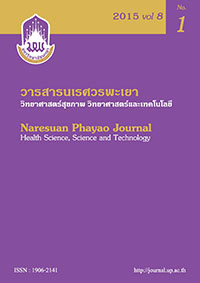การย่อยสลายสารไกลโฟเสททางชีวภาพโดยแบคทีเรียที่แยกจากดินเกษตร
Keywords:
การย่อยสลายทางชีวภาพ, แบซิลส, ไกลโฟเสตAbstract
วัตถุประสงค์ของการศึกษาคือเพื่อประเมินค่าขีดความสามารถการย่อยสลายสารไกลโฟเสตทางชีวภาพโดย แบคทีเรียแยกจากดินเกษตร คัดแยกแบคทีเรียได้กลุ่มแยก 27 กลุ่มจากผืนดินเคยใช้สารฆ่าวัชพืชไกลโฟเสต มีกลุ่ม แยกของแบคทีเรีย 3 กลุ่มคือ LMC2, MMC2 และ PMA2 มีอัตราการย่อยสลายสารไกลโฟเสตทางชีวภาพสูงสุด อิงกับอนุกรมของกรดดีออกซีไรโบนิวคลีอิกในยีนแสดงให้เห็นว่า ทั้งสามกลุ่มมีการเรียงลำดับกรดดีออกซีไรโบนิวคลีอิก คล้ายคลึงกับแบคทีเรียวงศ์แบซิลัส การทดสอบกระทำโดยการบำบัดทดลอง 6 การออกแบบแบบสุ่มได้แก่ ดินไม่มี แบคทีเรีย ดินมีแบซิลส เมกาทีเรียม ดินมีแบซิลส ซับติลิส ดินมีแบซิลัส ซีเรียส และดินมีแบคทีเรียสามกลุ่มแยก ทำการทดลองซ้ำ 3 ครั้ง สกัดตัวอย่างดินโดยกระบวนการแยกสารประกอบเกิดระหว่างสองเฟสเพื่อระบุหาระดับความเข้มข้นของไกลโฟเสต ผลการศึกษาพบว่า แบซิลส ซับติลิสและแบซิลัส ซีเรียสสามารถย่อยสลายได้ร้อยละ 98.84 และ 98.46 ตามลำดับ
Biodegradation of glyphosate by bacteria isolated from agricultural soil
Tapana Cheunbarn*, Srikanjana Klayraung, Jurairat Eimina
School of Science, Maejo University, Sansai District, Chiangmai Province 50290
The objective of the study was to evaluate the biodegradation performance of glyphosate by bacteria isolated from agricultural soil. The 27 bacterial isolates were obtained from the plot where glyphosate herbicide was previously applied. Three isolates of bacteria; LMC2, MMC2, and PMA2 showed the highest rate in the glyphosate degradation. Based series finding of DNA in gene 16s rRNA, showed that bacteria isolates LMC2, MMC2, and PMA2 had bacterial DNA sequence similar to Bacillus megaterium, B. subtilis, and B. cereus (99%). The performance degradation testing of glyphosate in the soil was conducted by six experimental treatments in a complete randomized design: soil with no bacteria, soil with B. megaterium, B. subtilis, B. cereus, and mixture of the three isolates. The trials were replicated 3 times. The soil samples were extracted by using High Performance Liquid Chromatography (HPLC) to determine concentration levels for glyphosate. The results revealed that glyphosate was readily degraded by B. subtilis (98.84%), and B. cereus (98.46%), respectively.Downloads
Published
How to Cite
Issue
Section
License
ผู้นิพนธ์ต้องรับผิดชอบข้อความในบทนิพนธ์ของตน มหาวิทยาลัยพะเยาไม่จำเป็นต้องเห็นด้วยกับบทความที่ตีพิมพ์เสมอไป ผู้สนใจสามารถคัดลอก และนำไปใช้ได้ แต่จะต้องขออนุมัติเจ้าของ และได้รับการอนุมัติเป็นลายลักษณ์อักษรก่อน พร้อมกับมีการอ้างอิงและกล่าวคำขอบคุณให้ถูกต้องด้วย
The authors are themselves responsible for their contents. Signed articles may not always reflect the opinion of University of Phayao. The articles can be reproduced and reprinted, provided that permission is given by the authors and acknowledgement must be given.








